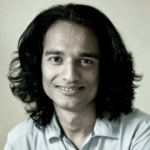
Teachers’ Day – 5 September
 By Kaushal Kishore
By Kaushal Kishore
Bharat Ratna Dr. Sarvepalli Radhakrishnan, a philosopher and educationist known to respond to the uniformed Western criticism of Indian civilisation and cultures, was elected to the public office of President of India in 1962. He had advised to celebrate the Teacher’s Day, when his students asked to celebrate his birthday.

As such the tradition of celebrations dedicated to the teacher on this day came into existence. Madan Mohan Malviya invited him as the Vice-Chancellor of Banaras Hindu University. In addition to that, he got the opportunity to teach in England and America. Today the countries that followed his advices are leaders in the field of education.

Bharat Ratna Aruna Asaf Ali, who was very active during the Quit India Movement, started teaching at the Gokhale Memorial School (Kolkata). She was the first Mayor of Delhi after independence. The nightingale of India, Sarojini Naidu is the spokesperson of the tradition of teachers that started with the advent of Savitribai Phule and Fatima Begum Sheikh. This list would be incomplete without the mention of Sucheta Kriplani and Malti Choudhary standing with Gandhi, who reached Noakhali to help the daughter of Jyotirmoyi Debi, Ashoka Gupta, who was there to restore peace after the communal violence. Sucheta Kriplani started her career teaching constitutional history in Banaras Hindu University, and became a member of the Constituent Assembly. After independence shebecame the chief minister of Uttar Pradesh. In the Kalinga region, Gopa Bandhu Das, Nab Krushna Choudhary and Malti Choudhary were the leading lights.
On the Western coast, not only Gokhale, Gandhi and Vinoba Bhave, but the teachers like Bal Gangadhar Tilak and Vishnushastri Chiplunkar were present. Aurobindo Ghosh and his disciple KM Munshi were in Gujarat. Bhimrao Ambedkar and Guru Golwalkar are known for their initiatives in nation building even after independence. Lala Lajpat Rai and DAV College in Lahore (Pakistan) are yet other examples. A century ago, Lala had established the centres of learning and public service like The Tilak School of Politics and Servants of the People Society. These monuments of traditional wisdom in modern India are an extension of the boundaries of Arya Samaj and Gurukul of Maharishi Dayanand Saraswati. Public figures like Lala Firoz Chand, Purushottam Das Tandon, Balwantrai Mehta and Lal Bahadur Shastri were present in the classroom there.
In the early stage of the freedom struggle, local groups had emerged at certain places to oppose the British. The tribals in Jharkhand with the leader like Birsa Munda and the Kuka rebellion in Punjab were from that part of the history. The role of teachers and students at the Sanskrit schools in struggle is also commendable. Anandamath of Bankim Chandra Chatterjee and Swami Shraddhananda’s Gurukul were the two different kind of manifestations of the art of teachings. By the end of the freedom struggle, apart from the bombs and guns of the revolutionaries, the Gandhian non-violent satyagraha got wider acceptance before the democratic rule.
The contributions of teachers and gurus are clearly visible in all the above cases. Even after independence, the teachers have played an important role in nation building. In order to maintain the tradition quality, we the people need to make serious efforts for its fulfillment.
Mushi Prem Chand and Dr. Amar Nath Jha were in the Hindi heartland. The academic experts like Firaq Gorakhpuri had also emerged during the same period. Acharya Kripalani, who joined the freedom struggle with the Khilafat movement, started his journey as a teacher. He had been a lecturer of English and History in the Muzaffarpur College for five years. Syed Ahmed Khan, Dr. Zakir Hussain and Master Radha Mohan Gokul also defined the relationship between the freedom and education in their own ways. Here the master of the revolutionaries like Chandrashekhar Azad and Bhagat Singh is known to have provided them with the weapons and money to carry certain operations.
Bipin Chandra Pal, the spokesperson of nationalism in Bengal, was appointed as a teacher in the college where he was a student. Shyama Prasad Mookerjee was the Vice Chancellor of the University of Calcutta. In East Bengal, the leader of the independence movement Surya Sen is referred to as Master Da. He was hanged for revolutionary activities on January 12, 1934 at Chittagong, and will continue to inspire generations of the teachers. The ‘Bhadra Lok’ of Bengal like Raja Ram Mohan Roy, Ishwar Chandra Vidyasagar and Rabindranath Tagore made important contributions to education and freedom struggle.
The Telugu speaking Dr. Radhakrishnan taught at Kolkata for more than a decade between the two world wars. This protagonist of the Niyogi Brahmins was of the view that the best minds in the country should be teachers. To solve the complex problems of today, the first condition is to get it on the ground.
*Kaushal Kishore is the author of The Holy Ganga (Rupa, 2008) and Managing Editor of Panchayat Sandesh, a monthly organ of All India Panchayat Parishad. The views expressed as personal.





